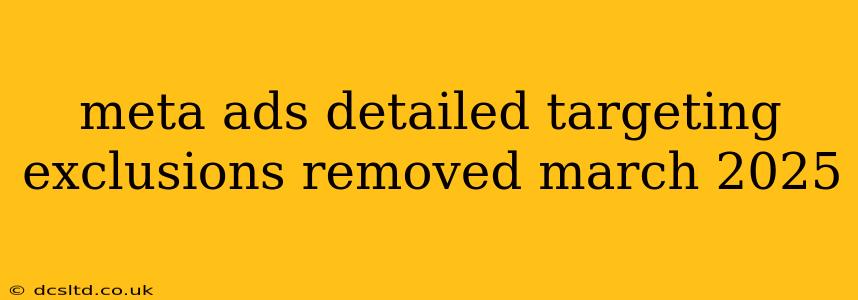The digital advertising landscape is constantly evolving, and Meta (formerly Facebook) is no stranger to significant changes. One such shift, impacting advertisers significantly, was the removal of detailed targeting exclusions in March 2025. This article delves into the implications of this change, exploring its impact on targeting strategies and providing insights for navigating this new advertising reality. We'll also address frequently asked questions surrounding this update.
What Does This Mean for Meta Advertisers?
The removal of detailed targeting exclusions means advertisers can no longer exclude specific demographic groups or interests from seeing their ads with the same granular precision as before. While Meta still offers broad targeting options and allows for exclusion based on larger categories, the level of control previously available is significantly reduced. This change is driven by Meta's ongoing commitment to inclusivity and a move toward more generalized targeting methodologies.
This shift has profound implications for advertisers accustomed to highly refined targeting strategies. It forces a reevaluation of existing campaigns and the adoption of more inclusive, yet potentially broader, targeting approaches.
How Can I Still Achieve Precise Targeting Without Detailed Exclusions?
While precise exclusion targeting is gone, marketers aren't completely left in the dark. Here are some strategies to navigate this change:
-
Refine your creative: Instead of excluding specific groups, tailor your ad creative to resonate with a broader audience. A well-crafted ad message can inherently appeal to your target while naturally excluding less relevant demographics.
-
Utilize Lookalike Audiences: Leverage Meta's Lookalike Audience feature to target users similar to your existing customers. This approach helps focus your ads on individuals likely interested in your product or service.
-
Focus on contextual targeting: Consider utilizing contextual targeting, which aligns ads with relevant content and websites, providing a more organic way of reaching your ideal customer base.
-
Implement detailed audience segmentation within your ad campaigns: Though you can't exclude specific interests with granular precision, you can still create very detailed audience segments through layered targeting. Combine multiple interests and demographics to build more focused audiences, even without exclusion capabilities.
What are the Benefits of this Change?
While the initial reaction may be negative, this change by Meta also presents some potential benefits:
- Increased reach: Broader targeting potentially exposes your ads to a larger audience, leading to increased brand awareness and potential customer acquisition.
- Improved inclusivity: Meta's aim is to foster a more inclusive environment. By reducing granular exclusion capabilities, they aim to promote fairer ad delivery across all user segments.
- Focus on creative optimization: The shift encourages a greater emphasis on crafting compelling and highly relevant ad creatives, ultimately improving campaign effectiveness.
Will This Impact My Campaign Performance?
The impact on campaign performance will vary greatly depending on your existing targeting strategies and the nature of your business. Some advertisers may experience a slight decrease in conversion rates initially, while others might see improved reach and brand awareness. Closely monitor campaign performance post-March 2025 and adjust your strategies as needed. A/B testing different approaches will be crucial in optimizing your campaigns within this new framework.
How Can I Prepare for This Change?
Proactive preparation is key. Review your current targeting strategies, identify potential vulnerabilities, and start experimenting with alternative approaches before the detailed targeting exclusions are removed. Focus on creating highly relevant and compelling ad copy and visual elements.
What Alternatives to Detailed Targeting Exclusions Exist?
While perfect replacements may not exist, Meta offers several alternative approaches to refined targeting:
- Detailed Targeting (with limitations): You can still utilize detailed targeting but without the ability to exclude certain demographics with the previous level of precision.
- Lookalike Audiences: These audiences offer a powerful way to reach users similar to your existing customers.
- Custom Audiences: Utilize custom audiences based on email lists or website activity to target users already familiar with your brand.
The removal of detailed targeting exclusions represents a significant shift in Meta's advertising platform. By understanding the implications and adapting your strategies proactively, you can navigate this change successfully and continue to achieve your marketing objectives. Remember to prioritize creative optimization and flexible audience segmentation to maximize your campaign effectiveness in this new environment.
